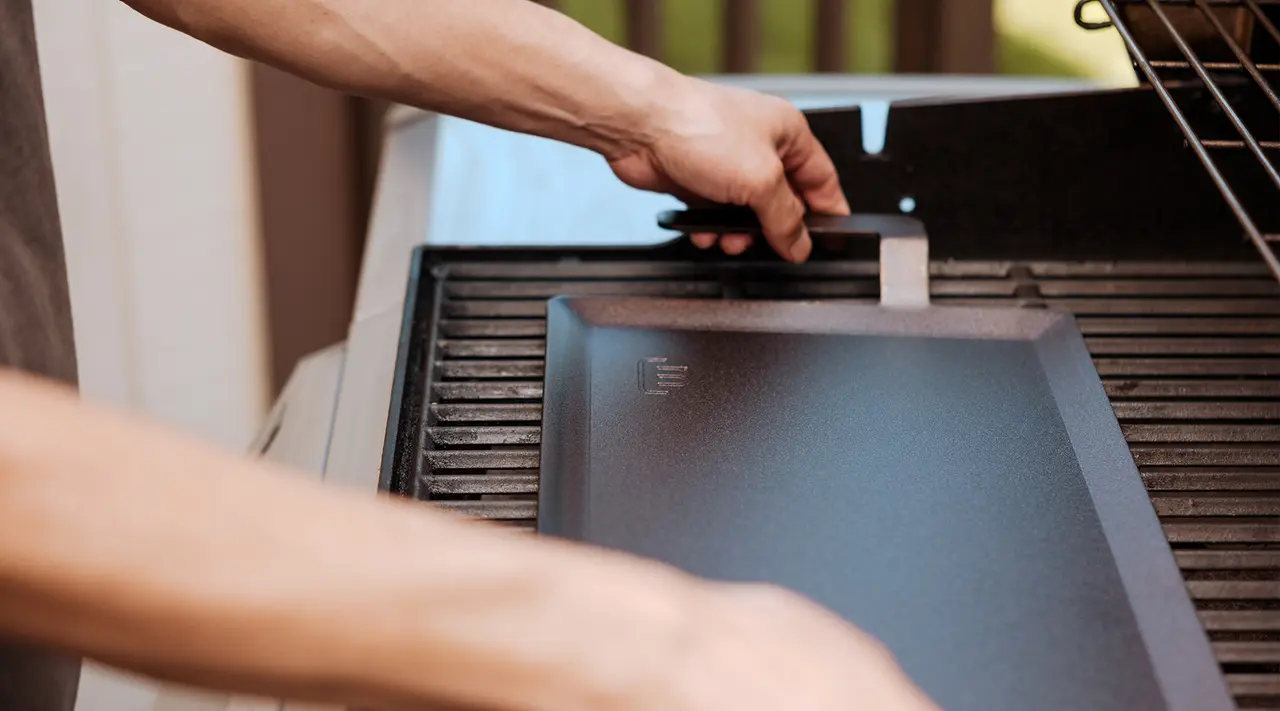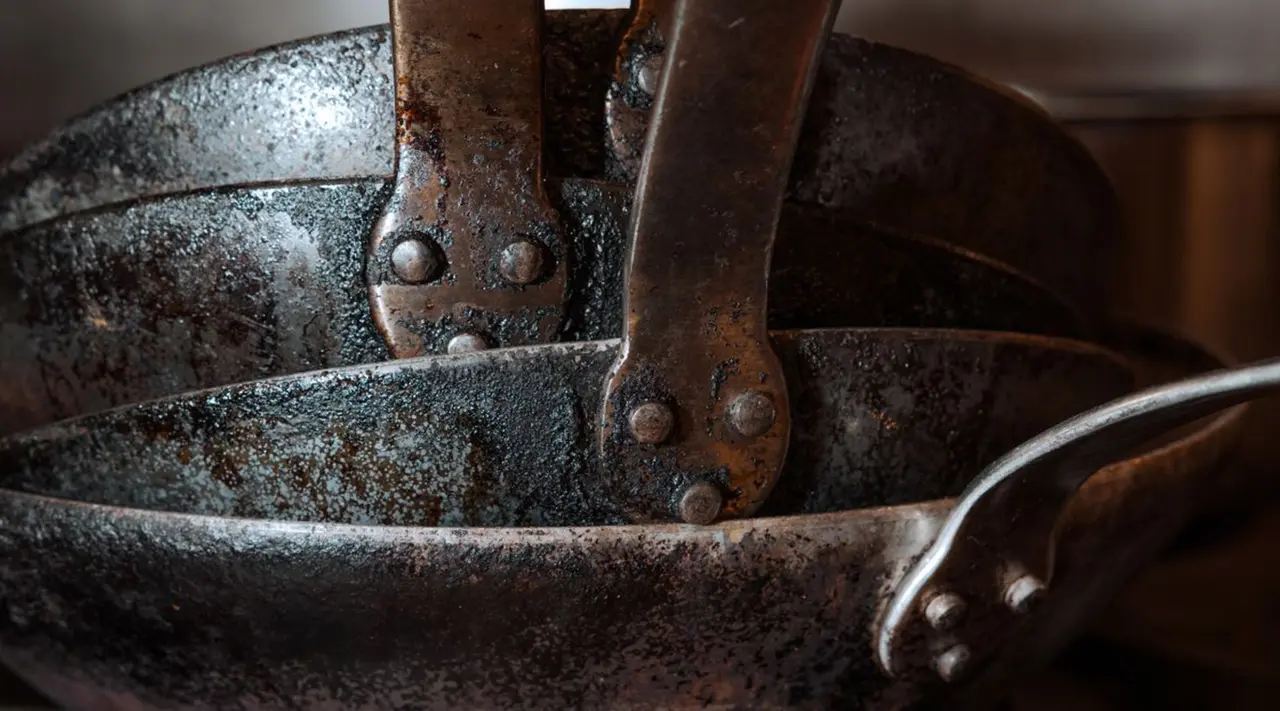Our Carbon Steel Griddle provides a large, flat surface on which to cook up all manner of foods, from lacy-edged smash burgers and fluffy pancakes to perfectly melty grilled cheese sandwiches. We designed our Carbon Steel Griddle to include sloped sides, which keeps grease from running off the griddle and onto your stove or grill, but still maintains the signature flat cooking surface that you want from a griddle.
A well-seasoned carbon steel griddle provides a naturally non stick cooking surface that cleans up easily. Similar to other carbon steel cookware, a carbon steel griddle requires a few specific maintenance items to keep it in tip top shape. Read on to learn how to care for your carbon steel griddle.
Preparing Your Carbon Steel Griddle for First Use

Our Carbon Steel Griddle comes pre-seasoned with two layers of coconut oil and shea nut oil. Give it a quick wash out of the box with warm water and a soft sponge or dishcloth, then you’re ready to go. If you’d like to add an extra layer of non stick protection, then feel free to add another layer of seasoning before using your griddle for the first time. Check out our guide to seasoning carbon steel to learn more.
Once you’re ready to use your griddle, place it over two burners and preheat the griddle over medium-low heat for about three minutes. Add enough oil to coat the griddle’s surface, then use a paper towel or clean dishcloth to spread the oil around the entire surface (including the edges).
When your griddle is preheated and the oil hot, you can tinker with the temperature on either burner. For example, turn one end up to medium-high to fry an egg or cook some bacon, but keep the other at medium-low to cook some pancakes. With frequent use, you’ll learn how to best control the temperature depending on the food you’re cooking.
Once you’ve finished cooking, it’s time to clean.
Daily Care and Maintenance Routine
Like all of our cookware, it’s important to clean and remove any food residue after use to prevent sticking and problems later on. Luckily, the process is typically simple when cleaning the griddle:
- Turn off the heat and use a wooden or silicone spatula to scrape off any excess food while the griddle is cooling—avoid sharp-edged utensils that could scratch through the seasoning.
- Let the griddle cool, then run it under some water (either in the sink or with a spray bottle) and wipe with a dish sponge—sans soap—or paper towel. Use some coarse salt or your spatula if there’s any stubborn residue clinging on, then rinse again.
- Once the griddle is clean, dry completely with a clean towel before storing. If needed, place it back on the stovetop on low for a few minutes to let it completely dry.
In-Depth Cleaning Tips
There are some cooking tasks that can result in more stubborn residues. If you find your pan has stuck-on bits or a sticky residue, make a paste of oil and coarse salt, then use a sponge or dishcloth to buff the spots off. For really messy spots, you might need to boil water atop the griddle and scrape at the stubborn spots with your spatula.
In both cases, you’ll also likely be stripping away some of the seasoning. Be sure to re-season your carbon steel griddle after a deep cleaning—even if it just feels a little dry after being cleaned.
How to Store Your Griddle
To prevent rust, ensure your griddle is entirely dry before carefully storing it in a dry place. If you’re storing your carbon steel griddle with other cookware stacked on top, place a towel or non-scratching trivet between to prevent scratching the surface.
You may find that you’re using your griddle so much, though, that it’s most convenient to just store it right on the stove.
Long-Term Griddle Maintenance Tips

Treat your carbon steel griddle like you would other carbon steel or cast iron cookware: with a gentle touch. We suggest reaching for utensils that don’t scrape the surface too aggressively when cooking, along with these other tips.
Clean Between Batches
If you’re cooking a large amount of burgers, bacon, or something that produces a lot of grease, remove the accumulated grease between batches to avoid it pooling up and spilling over the edges. We like to use our bench scraper for this, but a wad of paper towels will do the trick.
Watch for Rust
Rust is a risk with carbon steel, especially if you live in a very humid environment, but our guide to removing rust from carbon steel provides detailed instructions should you run into this. To prevent rust in the first place, always dry your griddle immediately after washing. It’s also helpful to set the griddle over low heat to make sure it’s really dry—you can also take this opportunity to apply a thin layer of oil, which helps maintain the seasoning.
Reseason Your Griddle
It’s good practice to reseason your carbon steel griddle once or twice a year, depending on use. If the griddle seems a little dry and has a very matte surface, then it’s time to add another layer of seasoning. You’ll also need to reseason after doing a deep, scrubbing clean to remove residue, rust, or splotchy, uneven seasoning. With routine maintenance, your carbon steel griddle will keep turning out tasty meals for years to come.
Understanding Carbon Steel Griddles

Griddles in general are very functional, with their ample cooking surface allowing you to cook multiple items or meal components at once—they’re a mainstay in diners and restaurants for a reason! Since it’s made with carbon steel, our griddle is light and easily portable, plus it can handle the high, direct heat of a stove or an outdoor grill. It can even handle direct flames—meaning you can and should pack this griddle in your camp cooking kit.
Our professional-grade 4mm Carbon Steel offers more precise temperature control than a cast iron griddle, too. And an added bonus: its hand-welded, raised ergonomic handles make for an easy transition from stove to grill.
Though carbon steel in general can seem intimidating or tricky to cook with, with a few easy cleaning and use tips a carbon steel griddle can quickly become an everyday part of your cooking routine.
Ready to Shop?
Our Carbon Steel Griddle provides a super versatile cooking surface and can transition from stove to grill, making summertime cooking especially fun. We’ve gathered several recipes that are excellent on the griddle, but as you’ll soon learn, the more you cook with it, the more you’ll wonder how you ever got by without a carbon steel griddle of your own.






























